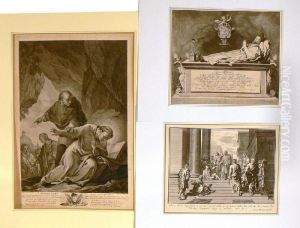C. Bloemaert Paintings
Cornelis Bloemaert II was a Dutch Golden Age painter and engraver. Born in Utrecht in 1609, he was part of a prominent family of artists; his father, Abraham Bloemaert, was a well-known painter and draftsman. Cornelis received his initial training from his father and developed his skills in the artistic environment that surrounded him. His brothers, Hendrick, Adriaen, and Frederik Bloemaert, were also involved in the arts as a painter, engraver, and a print-seller, respectively.
Bloemaert's work was influenced by the Baroque style, which was characterized by dramatic expression, rich coloration, and bold manipulation of light and shadow. He specialized in engravings and was known for his skillful reproduction of the works of other painters, thus helping to disseminate the Baroque style throughout Europe. He worked in Rome for a significant part of his career, which was typical for Dutch artists of the time who sought to refine their skills and absorb Italian artistic influences.
In Rome, Cornelis became associated with the group of Northern artists known as the 'Bentvueghels', a society of mostly Dutch and Flemish artists working in Rome. He was known by the nickname 'Bloem' within this group. His engravings after the Carracci, Guido Reni, and other Italian masters were highly regarded and contributed to his fame.
Cornelis Bloemaert's engravings cover various subjects, including religious themes, portraits, and mythological scenes. His works were often produced as illustrations for books, contributing to the spread of Baroque art and ideas. His legacy is that of a skilled engraver who played a role in the international exchange of artistic styles during the 17th century.
Cornelis Bloemaert II passed away in Rome in 1685. His engravings remain a testament to his technical skill and are studied for their role in the art historical narrative of printmaking and the dissemination of Baroque aesthetics.
